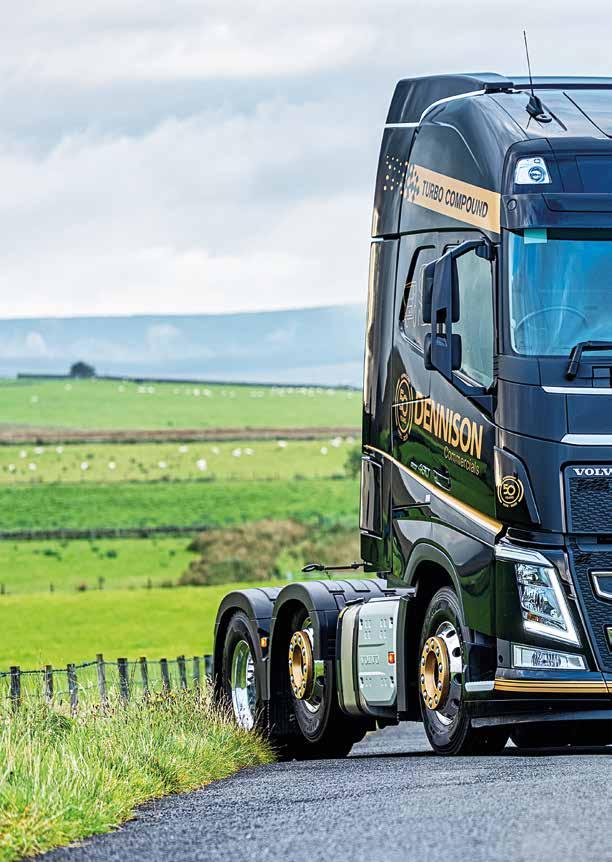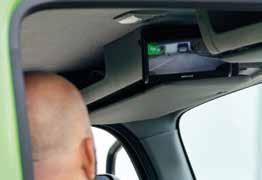
14 minute read
Seamus Leheny, Logistics UK Policy Manager-NI
Seamus Leheny
Policy Manager - Northern Ireland. Logistics UK
TRADER SUPPORT SERVICE: A LIFELINE FOR NI BUSINESSES IN A TIME OF DISTRESS
Well, we didn’t see that coming. What an utterly horrible six months we as an industry and society have endured. COVID-19 and the subsequent lockdown have had a hugely damaging and long-lasting effect on the logistics sector. The pandemic’s impact on our daily lives, the economy and our industry has been merciless, especially on those operators who were vulnerable given the sectors they work in and the commodities they transport.
Some operators here in Northern Ireland saw their entire supply chains grind to a halt overnight, leaving no option but to park up trucks and furlough staff. Others were more fortunate simply due to the lottery of which customers stayed open and which businesses closed. However, over the last six months our industry has not just done itself proud with how it kept vital supply chains open during difficult times, but it showed its resolve and true grit in solving problems and keeping our shops stocked, fuel delivered, factories replenished and medical supplies moving. The role of our drivers and the industry overall was recognised and appreciated by the public and the media, and this is something we must build on as we move forward and work our way back to recovery. In the first few weeks, much of my time was spent working for derogations such as delivery times permitted to shops, drivers’ hours rules, DCPC validity, ADR, IVA, vehicle testing and driver licence renewals. Some of these were straightforward enough but others were more complex, but thankfully we got there on all of them. Some problems remain, such as limited capacity for vehicle testing, which is causing problems for maintenance service providers and operators trying to ensure they have vehicles prepared and available when they need them. The biggest disappointment has been the lack of financial support from government for those hardest hit in our industry. The furlough and CBILs scheme were welcome and certainly saved many businesses, but the lack of a grant aid package could have a long lasting impact. In May I gave evidence to the Northern Ireland Infrastructure Committee in Stormont on how our industry was coping during COVID-19. My key ask that day, which remains the same today, was for a means tested aid package for those operators who need it most. I acknowledged not all operators were suffering equally, hence why those in need could demonstrate why they needed help and thus ensure they remain financially sustainable.
Giving evidence to the Northern Ireland Infrastructure Committee in Stormont.
Before that meeting and ever since we have a game of ‘pass the hot potato’ between different ministers over who is responsible and able to deliver aid to hauliers in need. We will keep asking those questions and as I have warned, the real impact was never going to be felt in the early months of COVID-19, but later in the autumn when payment holidays and furlough end and we start to see what the impact of the inevitable recession looks like on the wider industry. For now, operators here will strive to continue carrying out their work professionally and admirably which were the very qualities that got us through those dark months of COVID-19.
Brexit Beckons
In the midst of everything else, it has been all too easy to forget that Brexit is still here and we are quickly getting closer to 1 January 2021, which will see the biggest change in how we move goods into and out of Northern Ireland. Following the development of the Northern Ireland Protocol, Logistics UK has been pressing the government to provide financial support for Northern Irish businesses who will need to adapt to the new NI-GB trading procedures post-EU exit. So, following many meetings with government ministers, we were relieved when the government announced the creation of the Trader Support Service. This £200million scheme will provide traders with an end-to-end service to guide them through all import processes, including handling digital import and safety and security declarations on their behalf, at no additional cost. Northern Irish businesses face significant challenges at the end of the transition period, not least the challenges of customs documentation and other formalities, which many would be encountering for the first time. The support package will ensure the cost of implementing or enforcing new border arrangements will not fall solely onto business or logistics providers. It will provide a vital lifeline for NI businesses concerned about the new administrative tasks they face. However, with fewer than 130 days until the end of the transition period – and the scheme operator only due to be announced as I write this in September, there is very little space for the new systems to be trialled and implemented. This will be made more complex by the challenges posed by the festive season, which is traditionally the logistics sector’s busiest working period. And, while the support package is most welcome, there are still several other areas of concern the government must address. Logistics UK has worked with its members to identify the key measures needed to keep trade between NI and GB moving efficiently. These include ongoing engagement with logistics businesses; minimising frictions, red tape and costs for industry; and customs training and support to build customs capacity. As the UK forges its new relationship with the EU, the maintenance of flexible, frictionless trade between NI and GB is vitally important to the continued recovery and success of our economy. In the meantime, we advise all our members to continue with their Brexit preparations and seek support from the Trader Support Service if possible. For more information on the Trader Support Service, including how to register interest, please visit www.gov. uk/guidance/trader-support-service
Survey Suggests Over Half of HGV Drivers Don’t Do Regular Walkaround Checks
According to a new survey by vehicle and fleet safety specialists CameraMatics, the majority of HGV drivers do not consistently carry out checks.
CameraMatics surveyed over
500 UK and Ireland based drivers, asking how often they carry out daily walkaround checks. Somewhat shockingly almost 40% (39.3%) of drivers responded ‘I never do checks’, with a further 15.8% saying they rarely complete checks. Walkaround checks should be a part of every driver’s pre-journey routine. The best way of ensuring this is for operators to have processes in place for checks to happen and be recorded. But, according to the survey results, it seems all too frequently they are missed. And at what cost? Checks are important for a whole range of reasons. Completing them means drivers and fleet operators are constantly aware of the state of their vehicles. The DVSA reported in January 2020 that 85% of lorry defects can be picked up during a walkaround check. Very often these defects are quickly and inexpensively solved. Leaving the depot with a defective vehicle can store up trouble – and in many cases, danger. Problems don’t disappear on their own and driving a vehicle that isn’t fully functional is putting the driver, the operator, and other road users at risk. There’s also the legal aspect. Drivers can receive an unlimited fine and
even a prison sentence for using an HGV in a dangerous condition, and there are many sanctions for operators too. In the event of an accident, incident, or being pulled over by an enforcement agency, evidence of adequate walkaround vehicle checks will be sought. Lack of evidence could lead to insurance issues in the event of a claim or pay-out. In this circumstance, both the driver and the operator can be liable. CameraMatics also surveyed over 250 HGV fleet managers about vehicle checking systems. Surprisingly, given the digital age we live in, over 50% of respondents are still using a pen and paper system for checks. Commenting on the results, CameraMatics Founder & Director, Simon Murray, said, “It’s concerning to hear that over 50% of drivers say they do not carry out regular walkaround checks. Our experience tells us that using an app like CameraMatics Go for walkaround checks significantly improves safety and compliance. He continued, “It allows fleets to ditch unreliable and inefficient pen and paper systems. As well as giving managers an instant notification of check completion and results there’s also a time and locationstamped record of every check. This can be crucial in the event of enforcement or insurance issues.”
Ireland’s leading workshop specialist for haulage, transport, plant and fleet

SWS is Ireland’s leading garage fit-out and workshop equipment specialist. With over 40 years’ experience and access to the world’s leading brands, we are trusted by operators who value our expertise, reliability and exceptional value.
TRUSTED FOR THE JOURNEY

STERTIL KONI VL TEST SYSTEMS SAMOA MAJORLIFT
SALES TEAM (028) 7131 2225 WWW.SWSNI.COM
DENNISONS FH 460 I-SAVE DEMONSTRATOR PROVES AN ECONOMICAL TRIUMPH FOR BUSINESS


As fuel economy continues to become a key driver in which manufacturer an operator chooses, understanding the best and most fuel-efficient vehicles on the market is crucial.

FOR MORE INFORMATION ON THE VOLVO FH WITH I-SAVE CONTACT DENNISON COMMERCIALS BY VISITING, WWW.DENNISONS.CO.UK or CALLING 028 9335 2827
Volvo has proven its worth with the FH I-Save package, which includes I-See predictive cruise control and, more significantly, the turbo-compound unit, promising outstanding fuel efficiency and incomparable driveability. The highly effective Volvo D13 turbo compound promises to be Volvos most fuel-efficient engine ever. Available in two different power ratings, the 460 engine produces a torque of 2600NM which is equivalent to the normal, diesel aspirated 540HP, and the 500HP engine is equivalent to the 16L 550HP delivering 2800NM. This is achieved through bespoke pistons with a patented wave-shaped interior that improves combustion and increases efficiency. In late 2019, the new I-Save model took part in Commercial Motor’s famous road-test, where they focused firmly on economy. The new model broke the fuel test record reaching an impressive 9.49 MPG average on its journey – the first truck to ever reach over 9MPG around the Commercial Motor route. Locally, operators have been trying out this highly acclaimed truck through Dennisons, in their smartly dressed FH-460 demonstrator.
Impressive Returns
Designed for long haul journeys, the Volvo FH with I-Save has lived up to its promises, specifically when local operators drove the truck on its preferred, long-distance journeys. For local, multi-stop applications, the truck still delivered credible figures. Looking at the companies who tried out the Dennisons demo, the lowest average mile per gallon was operator 10. This operator works within the waste and recycling sector pulling bulk waste, running fully freighted at 44 ton. Although the bottom result at 8.68mpg across 1966 miles, their normal fleet average is 5.5mpg – giving the operator an astonishing increase of 3mpg. Operator 13 was the highest in the group reaching a surprising 10.86mpg. Specialising in container and curtainsider work, this driver was completing longer miles across Ireland, explaining how they reached such an impressive figure. Chris Arthur, Sales Manager of Dennisons said: “The beauty of the new I-Save model allows operators

to have incomparable fuel efficiency without the truck compromising on power. The truck will still perform as well as a standard FH, with less noise and uncompromised torque value. The feedback we are hearing from our customers, is that the driving experience is still as good as ever.”
Significant Order
On the back of trying out the Dennisons demonstrator, Culina Group have ordered an impressive 21 trucks to add to their national fleet. Mark Matkin, Fleet Director of Culina Group stated: “We carried out relentless tests on the Volvo FH with I-Save in both Northern Ireland and the wider UK, and we have been pleasantly surprised. The fuel figures that were returned, were too good to ignore. We will save significantly on fuel without compromising on driver comfort, and still getting that excellent pull power that Volvos are renowned for. We are thoroughly impressed with the I-Save model, which is why we have invested in 21 of this particular model.” Since the beginning of the year, a third of Dennisons FH order intake has gone to the I-Save model. This shows how highly praised the new model is within the local market.
COMPARISON TABLE
Operator Miles Average MPG In Demo Operator 1 3112 8.74 Operator 2 3807 9.72 Operator 3 5688 9.15 Operator 4 4171 9.96 Operator 5 4666 10.36 Operator 6 6486 10.42 Operator 7 2192 10.49 Operator 8 1766 9.25 Operator 9 2630 9.14 Operator 10 1966 8.68 Operator 11 2167 9.55 Operator 12 2798 10.09 Operator 13 1681 10.86
Side View


Rear view
YOUR GUIDE TO CHOOSING A VEHICLE CAMERA SYSTEM
Vehicle camera systems have become commonplace for HGVs, trucks, construction vehicles and heavy equipment. As well as aiding driver manoeuvrability, they support road and site safety by eliminating vehicle blind spots and helping to prevent incidents.
However, deciding which vehicle camera to install can be difficult. Here Emily Hardy, from Brigade Electronics, provides some technical insight into which cameras are available, how they should be applied and whether you should consider upgrading to high definition (HD) format. Front view cameras are recommended for machinery, road going haulage and delivery vehicles. Due to the size and elevated driver position of machinery and trucks, a blind spot often exists to the front. A front view camera will eliminate this blind spot and help to prevent front vehicle damage. When choosing a camera, it’s worth bearing in mind health and safety directives in your sector so that these are fully covered. For example, ISO 5006 stipulates that operators of earth moving machinery must be able to see a person 1.5m high within 1m perimeter around the machine. Additionally, for HGVs, blind spot directive 2003/97/EC (Class VI) requires that a front view camera is mandatory for forward speeds below 30kph. Side view cameras are recommended for road going vehicles, including HGVs, buses, coaches, construction, and waste and refuse vehicles. The nearside blind spot is accountable for many collisions. Most cyclist fatalities happen at low speeds, typically at road junctions and when pulling away from a stationary position. Rear view cameras are ideal for all vehicles. Regardless of the type of vehicle, the rear blind spot is a huge problem with a huge 90% of reversing incidents occurring off road while one quarter of workplace deaths are caused by reversing vehicles. Reversing cameras are therefore a crucial piece of technology to prevent costly collisions, reduce damage, and save lives.
360 degree view
360-degree cameras
Recommended for all vehicles, intelligent camera monitor systems, like Brigade Backeye®360, are designed to assist low speed manoeuvring by providing the driver with a complete surround view of the vehicle in real time. Ultra-wide angle cameras mounted to the front, sides and rear of the vehicle capture the surrounding areas, including all blind spots. Simultaneous images from these cameras are then processed and ‘video stitched’ resulting in a 360-degree bird’s eye view in a single image.
Shutter cameras
Recommended for agriculture, construction, quarrying, and waste and recycling, a shutter camera can improve the life and visibility of a reversing camera considerably. Where vehicles operate in harsh environments, reversing cameras usually attract dirt and dust on the lens, blocking the driver’s view and rendering the camera useless. The shutter protects the camera by only revealing the lens when it is in use, reducing exposure time significantly. Brigade’s shutter camera has an operating temperature as low as -40 degrees C, and in-built heaters to melt away ice, meaning even in extreme temperatures it will function effectively.
Vehicle CCTV cameras
Meanwhile, vehicle CCTV cameras are a must for recording footage both inside and outside a vehicle. Incidents involving vehicles are time consuming issues to resolve. Having recorded footage where there are conflicting reports of actual events or being able to prove a staged accident means companies can make major cost savings in the long-term. More importantly, they can also support their drivers, who are often the subject of increased scrutiny after an incident. Vehicle CCTV cameras provide an accurate witness and irrefutable evidence in the case of an incident.
High Definition
Should I use high definition vehicle cameras? One of the most recent additions to the vehicle camera system portfolio is high definition (HD) cameras. These do exactly what you would expect – provide images in high definition format, which are clearer and more defined. This makes HD ideal for industries such as construction and quarrying where safety is a huge concern. However, there are a number of factors to consider before making the jump to HD. For example, if you already have a vehicle CCTV system installed, it is most likely not compatible with the HD camera. Likewise, recording in HD format will require more data and therefore use up a lot more space on a hard drive, or tear through data allowance for cloud-based storage, far more quickly. In the event of a security incident, HD cameras are ideal for recording footage, supplying clearer images and making it easier to identify individuals, number plates and other important information that may be required for gathering evidence.










